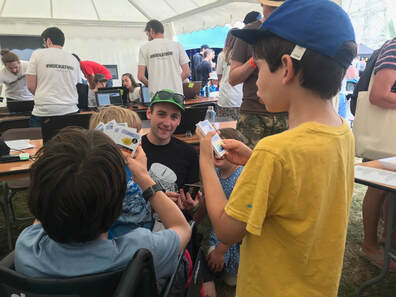
Why make climate food flashcards?
We wanted to find a fun way to engage with the public and children about the variation of greenhouse gas emissions caused by producing different foods. While there is always a range of values depending on how the foods are produced, and emissions are often difficult to measure, we felt that providing some fun typical numbers in an accessible format could help get across some of the most important issues.
We also wanted to get across some information on nutritional value, to start conversations with the public and children about healthy sustainable diets. We are excited to have water footprints too, which can start a conversation about trade-offs between environmental impacts.
We wanted to find a fun way to engage with the public and children about the variation of greenhouse gas emissions caused by producing different foods. While there is always a range of values depending on how the foods are produced, and emissions are often difficult to measure, we felt that providing some fun typical numbers in an accessible format could help get across some of the most important issues.
We also wanted to get across some information on nutritional value, to start conversations with the public and children about healthy sustainable diets. We are excited to have water footprints too, which can start a conversation about trade-offs between environmental impacts.

How to Play:
You can make up your own rules for how to use the cards, or borrow some from games like Top Trumps. For example: deal out 5 or more cards per person (two or three people is ideal), and choose someone to start the game. Players should not shuffle their cards, but secretly look at them face up. The first person looks at their first card and chooses a category (e.g. 'Calories') and states the category and value (e.g. ' Calories 132'). The other people compare their numbers in this category and the highest value wins. The winner takes the three competing cards and puts them at the back of their deck. The winner then starts again by choosing a category from their next card. The winner is the person who stays in the game the longest (by having some cards). |
Access
You can download the free pdf here (subject to the Attribution-ShareAlike 4.0 licence CC BY-SA 4.0) - we printed them with the food+numbers on the front and the food (without numbers) on the back. (Or here is a version with 8 cards per sheet, also CC BY-SA.) We would really like to hear how you got on using the cards, especially if you use them at public events - your feedback helps us to improve the cards and get money to develop the cards further - thank you! Acknowledgements: We are very grateful to the Take a Bite out of Climate Change team for all their great ideas and interactions with the public at the Royal Society Summer Science Exhibition 2019 and Bluedot Festival 2019, which got the cards reaching a much bigger audience and led to lots of ideas for how to improve the cards. Thanks to this support we were able to create a new version of the cards which are the ones you can access through the above link. |
Health Warnings/Data details:
- Please seek professional advice before making significant changes to your diet, to take into account your own personal circumstances and the necessary balance of many essential vitamins and minerals. For example vegans must take vitamin B12 supplements.
- Greenhouse gas emissions and water footprints from food production vary significantly depending on the production method and country of origin. For example, see 'Poore, J. & Nemecek, T. (2018). Reducing food’s environmental impacts through producers and consumers. Science.' which you can download (including all data).
- The conversion between greenhouse gas emissions (g CO2e) and car time depends on the efficiency of the car and the car speed.
- To calculate the number of minutes driving from the g CO2e we had to assume a type of car. Note that cars vary in their emissions per mile. For climate food flashcards version 2, we assumed a typical UK car which causes 155 g CO2e / km.
- We also needed to assume a car speed. In this version we assumed the car is driving at 40 mph.
- For extreme enthusiasts and data geeks you can see the full information used to make the cards here.
Known Bugs/Requests (please send us more as you spot them!):
- Some teachers have asked for 'sugar' to be included on the cards. The numbers are all there but we're not sure whether adding more info would detract from the look of the cards. We could add 'salt' (and loads of others!) - but where to stop? Suggestions / preferences welcome.
- We would be grateful if you would let us know any suggestions for the layout, or if you're puzzled by any of the numbers so we can spot any more bugs and note them here - and fix them for v3!
